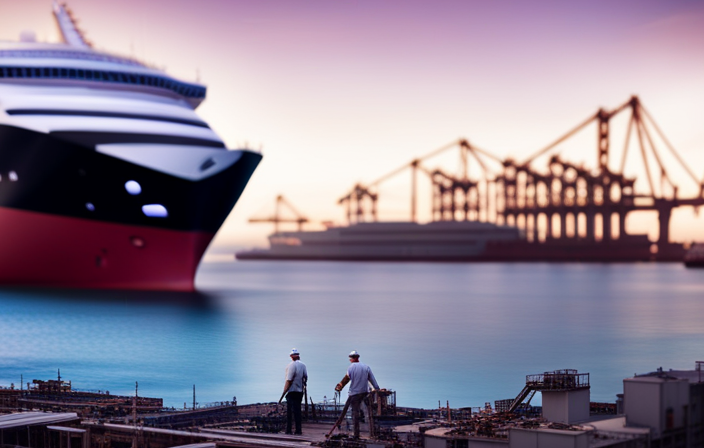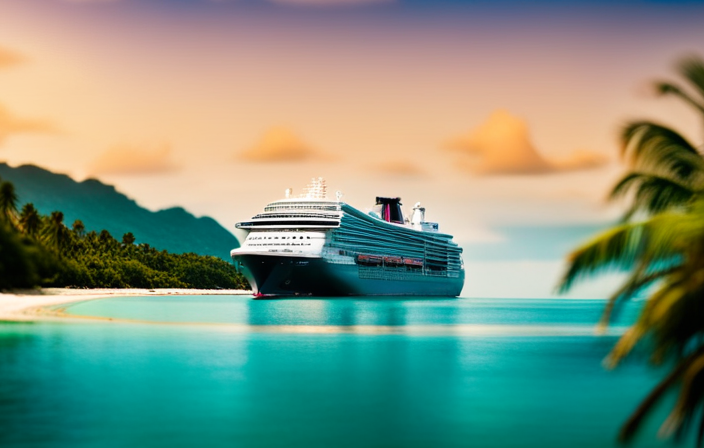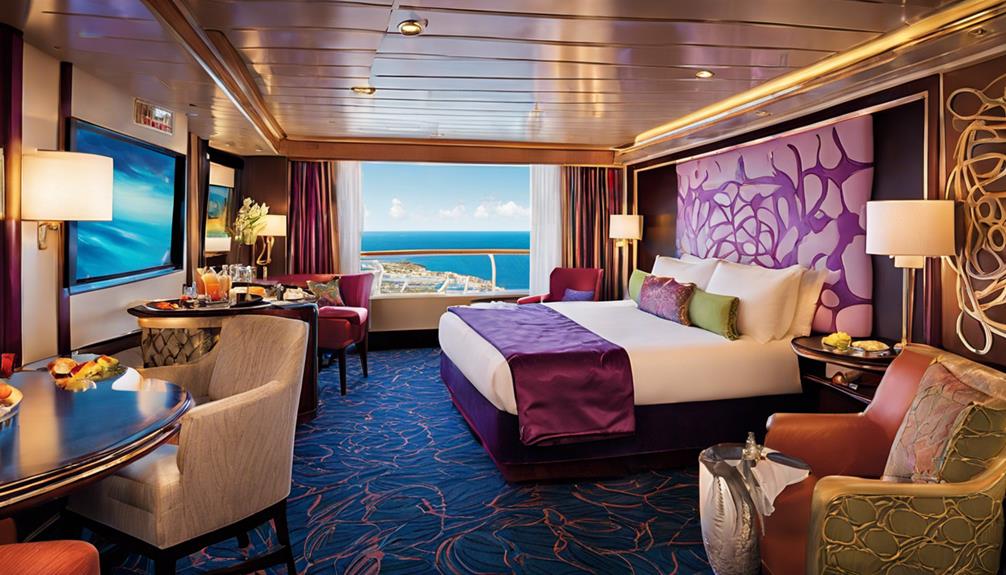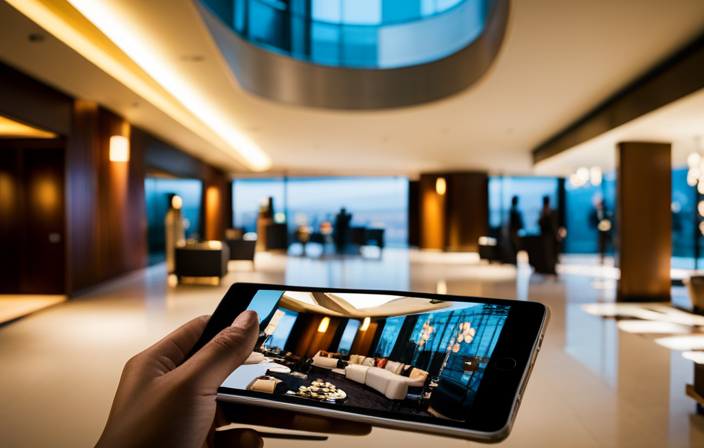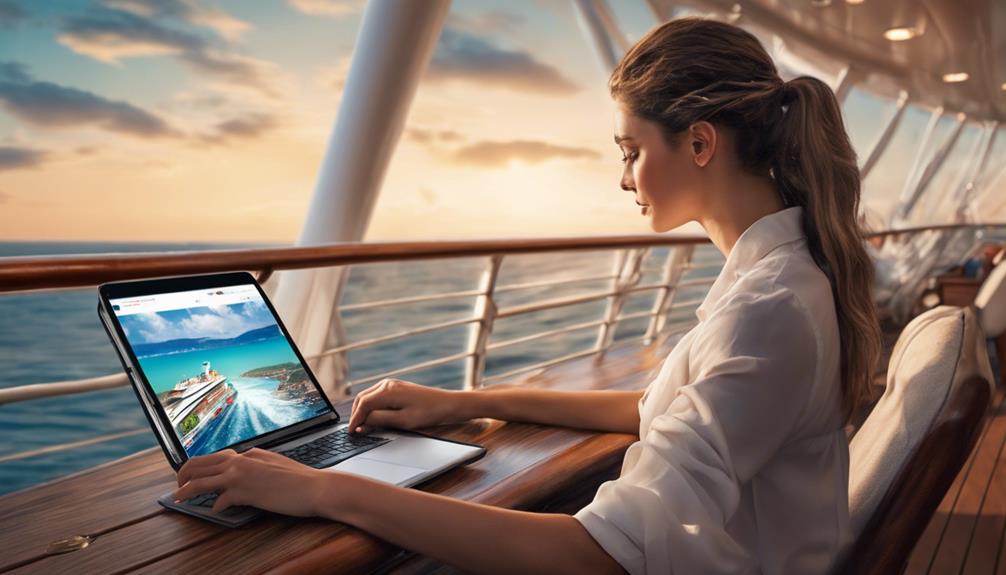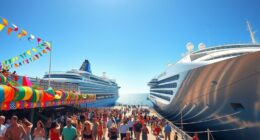I have always been captivated by the size and splendor of Carnival cruise ships. They resemble massive floating cities teeming with energy and exploration. Have you ever pondered the history behind these impressive vessels?
Well, let me take you on a journey to uncover the secrets behind the construction of Carnival cruise ships.
Just like a finely crafted masterpiece, Carnival cruise ships are meticulously designed and constructed with precision and expertise. They are born in shipyards, where the magic happens. These shipyards, located in various locations around the world, are buzzing with activity as naval architects and engineers work tirelessly to bring these dreams to life.
Using state-of-the-art construction techniques and high-quality materials, these skilled professionals ensure that every detail is perfect. From the initial planning and design stages to the final touches and preparations for passengers, every step of the shipbuilding process is carefully executed.
Join me as we delve into the fascinating world of Carnival cruise ship construction, exploring the construction locations, the role of naval architects and engineers, and the thrilling maiden voyage that marks the beginning of a new adventure.
Key Takeaways
- Carnival cruise ships are meticulously designed and constructed with state-of-the-art construction techniques and high-quality materials.
- Shipyards around the world, such as Fincantieri in Italy and Meyer Werft in Germany, are chosen based on reputation, experience, and ability to handle large-scale projects.
- The construction process involves assembly of the hull, installation of propulsion systems, and outfitting of cabins and public areas, taking into consideration efficiency, passenger comfort, and environmental impact.
- Carnival cruise ships primarily use block construction with high-strength steel as the main material, along with some areas utilizing advanced composite materials.
The Shipbuilding Process
The shipbuilding process is a fascinating journey where skilled craftsmen and engineers come together to transform raw materials into magnificent Carnival cruise ships. Shipbuilding techniques have evolved over the years, incorporating advanced technologies and innovative designs.
From selecting the appropriate shipyard to assembling the various components, every step is carefully planned and executed. Shipyard selection is crucial, as it determines the expertise and capabilities available for construction. Carnival cruise ships are built in various shipyards around the world, chosen for their reputation, experience, and ability to handle large-scale projects.
Once the shipyard is chosen, the construction process begins, involving the assembly of the hull, installation of propulsion systems, and outfitting of cabins and public areas. This intricate process requires precise coordination and attention to detail.
Now, let’s move on to the next section, where we delve into the design and planning of these magnificent cruise ships.
Design and Planning
Imagine being involved in the process of creating these incredible floating marvels, carefully crafting and envisioning every detail of their design and layout. Designing a Carnival cruise ship is no small task. There are various design challenges that must be overcome to ensure the ship is not only aesthetically pleasing but also functional and safe.
From creating efficient spaces to maximizing passenger comfort, every aspect of the ship’s design is carefully considered. In addition to the design challenges, there are also important environmental considerations that must be taken into account. Cruise ships are large structures that have a significant impact on the environment. Designers must find ways to minimize this impact by incorporating sustainable materials, energy-efficient technologies, and waste management systems.
When it comes to the construction locations of Carnival cruise ships, they are built in various shipyards around the world. These shipyards have the necessary facilities and expertise to handle the complex and intricate process of building these massive vessels.
Construction Locations
Get ready to explore the world of construction locations for these incredible floating marvels, because you’ll be amazed at the diverse shipyards around the globe where they’re crafted.
Carnival Cruise ships are built in various locations, each with their own unique construction timeline and environmental impact. One of the main shipyards where Carnival Cruise ships are constructed is the Fincantieri shipyard in Italy. Known for its expertise in shipbuilding, Fincantieri has been a long-standing partner of Carnival Corporation.
Another significant shipyard is the Meyer Werft shipyard in Germany, which has a reputation for producing high-quality vessels. These shipyards prioritize sustainability and implement eco-friendly practices to minimize their environmental impact.
From the construction of the hull to the installation of the luxurious amenities, the process involves the collaboration of naval architects and engineers who ensure the seamless integration of design and functionality.
With the construction complete, let’s now dive into the role of these talented professionals in shaping the Carnival Cruise experience.
The Role of Naval Architects and Engineers
From the early stages of design to the final touches, the skilled naval architects and engineers are the masterminds behind creating these floating wonders, ensuring that every detail is meticulously planned and executed. They play a crucial role in the shipbuilding process, working closely with the shipbuilders to bring the vision to life.
The role of naval architects is to design the structure and systems of the ship, taking into account factors such as stability, performance, and safety. Engineers, on the other hand, focus on the technical aspects, ensuring that the ship meets all industry standards and regulations. Their expertise and attention to detail are vital in ensuring the success of the shipbuilding industry.
The importance of the shipbuilding industry cannot be overstated, as it not only contributes to the economy but also provides employment opportunities and fosters technological advancements. As we delve into the next section about construction techniques and materials used, it becomes clear that the role of naval architects and engineers is essential in bringing these magnificent vessels to life.
Construction Techniques and Materials Used
Utilizing innovative construction techniques and cutting-edge materials, naval architects and engineers bring to life these floating wonders, crafting intricate structures that seamlessly merge form and function.
When it comes to construction techniques, Carnival Cruise ships are primarily built using a method called block construction. This involves assembling large prefabricated sections, or blocks, of the ship in a dry dock. These blocks are then lifted and carefully positioned using cranes to create the overall structure of the vessel. This technique allows for greater efficiency and precision during the construction process.
In terms of shipbuilding materials, Carnival Cruise ships are typically made from high-strength steel. This material is known for its durability and ability to withstand the harsh conditions of the open sea. Additionally, advanced composite materials are also used in certain areas to reduce weight and increase fuel efficiency.
As we move on to the next section about the assembly and integration of ship components, the meticulous craftsmanship and attention to detail continue to ensure the creation of exceptional cruise ships.
Assembly and Integration of Ship Components
The fascinating process of assembling and integrating ship components showcases the incredible craftsmanship and attention to detail that goes into creating these floating marvels.
Carnival Cruise ships are built using advanced assembly techniques in shipyards with large capacity and state-of-the-art facilities.
The shipyard capacity plays a crucial role in the construction process, as it determines the number of ships that can be built simultaneously.
The assembly techniques employed involve the careful alignment and fitting together of various components, such as hull sections, decks, and superstructures.
Highly skilled workers meticulously weld and secure these components to ensure structural integrity and durability.
With the completion of the assembly and integration phase, the ships are ready for the next crucial step: quality control and testing.
This phase ensures that every aspect of the ship meets the highest standards of safety and performance.
Quality Control and Testing
Get ready to experience the exciting phase of quality control and testing, where you’ll witness the meticulous checks and assessments that ensure the highest standards of safety and performance for these magnificent floating marvels. Quality control is an integral part of the shipbuilding process, ensuring that every component meets the strict standards set by Carnival Cruise Lines. From the engines to the cabins, every aspect of the ship undergoes rigorous testing to guarantee its reliability. This includes stress tests, functionality checks, and even simulated emergency scenarios to evaluate the ship’s response. In addition, quality control measures are implemented throughout the assembly process, with each stage carefully inspected to identify and rectify any potential issues. Carnival Cruise Lines leaves no stone unturned when it comes to ensuring the quality and safety of their ships. Moving forward, let’s delve into the exciting world of launching and delivery of the ship, where these incredible vessels finally set sail.
Launching and Delivery of the Ship
Now it’s time for you to witness the momentous occasion of your ship being launched and delivered, as these magnificent vessels set sail on their grand adventures.
The launch ceremony is a thrilling event that marks the culmination of months, or even years, of hard work by the shipyard management and construction team. It is a celebration of the ship’s completion and a testament to the craftsmanship and dedication that went into its construction.
The shipyard management oversees every detail, ensuring that all systems are functioning properly and that the ship meets all safety and quality standards. Once the ship is launched, it undergoes rigorous testing and sea trials to ensure its seaworthiness.
From here, the ship enters the final stage of preparation, where the crew adds the final touches and prepares for the arrival of passengers, creating an unforgettable experience for all who step aboard.
Final Touches and Preparing for Passengers
When it comes to preparing a cruise ship for passengers, there are two key points that must be addressed: interior furnishings and decorations, and crew training and safety drills.
The interior of the ship plays a crucial role in creating a comfortable and enjoyable experience for guests, with attention given to everything from the cabin design to the common areas and dining spaces.
Additionally, crew members undergo extensive training to ensure the safety and well-being of all passengers, with regular drills conducted to prepare for any potential emergencies.
These final touches are essential in ensuring a smooth and memorable cruise experience for all who step on board.
Interior Furnishings and Decorations
Imagine stepping into a Carnival cruise ship and being instantly transported to a world of luxury and elegance, where every corner is adorned with exquisite interior furnishings and decorations that make you feel like royalty on the high seas.
The interior design of Carnival cruise ships is carefully curated to create a welcoming and visually stunning environment for passengers. From the moment you step on board, you’ll be greeted by tastefully chosen furniture, from plush sofas and armchairs in the lounges to elegant dining tables and chairs in the restaurants. The furniture selection is not only aesthetically pleasing but also designed to provide comfort and functionality for guests.
The attention to detail is evident in every aspect, from the intricate patterns on the carpets to the artwork that adorns the walls. As you walk through the ship, you’ll be surrounded by a sense of opulence and refinement.
Speaking of refinement, let’s now transition to the next section about crew training and safety drills.
Crew Training and Safety Drills
Step on board and discover the world of crew training and safety drills, where you’ll be immersed in a hands-on experience that ensures your safety and well-being throughout your voyage.
Carnival Cruise Lines takes crew training very seriously, employing state-of-the-art techniques to prepare our staff for any emergency situation that may arise. From fire drills to medical emergency simulations, our crew members are trained to respond swiftly and effectively. They undergo rigorous training sessions that cover everything from crowd management to lifeboat drills, ensuring that they are fully equipped to handle any situation.
Our crew members are also trained in CPR and first aid, providing an extra level of safety and peace of mind for our guests. With our comprehensive emergency response procedures in place, you can relax and enjoy your cruise knowing that you are in capable hands.
As we wrap up the crew training and safety drills, we prepare for the next exciting chapter: the maiden voyage.
The Maiden Voyage
The Maiden Voyage of a cruise ship is an exciting and momentous occasion filled with anticipation and celebration. As the ship sets sail on its inaugural cruise, there are often special festivities and events planned to mark the occasion.
From a grand send-off ceremony to onboard parties and entertainment, the ship’s crew and guests come together to create a memorable experience. Passengers are welcomed with open arms as they step foot onboard for the first time, and the crew goes above and beyond to ensure their comfort and satisfaction.
The Maiden Voyage is a time of excitement and joy as the ship begins its journey and creates lasting memories for all those onboard.
Inaugural Cruises and Celebrations
Carnival cruise ships are typically built in shipyards in Europe, such as Italy or Germany. These shipyards have a long history of expertise in crafting magnificent vessels, ensuring that each Carnival ship is of the highest quality.
Once the ship is completed, it embarks on its inaugural cruise, which is a momentous occasion for both the cruise line and its passengers. These inaugural events hold great historical significance, as they mark the beginning of a new chapter in the ship’s life and the start of extraordinary journeys for countless travelers.
The atmosphere onboard during these cruises is electric, with excitement and anticipation filling the air. It’s a time when passengers eagerly explore the ship’s amenities, enjoy the first-class entertainment, and indulge in the delectable cuisine.
As the ship sets sail, it welcomes its first guests onboard, ready to provide them with unforgettable experiences at sea.
Welcoming the First Guests Onboard
After the grand celebrations of Carnival Cruise Line’s inaugural cruises, it’s time to welcome the first guests onboard. As a passenger, stepping foot on a Carnival cruise ship for the first time is an experience like no other. The excitement is palpable as you enter the ship and are greeted by the friendly and attentive crew.
From the moment you step onboard, you are immersed in a world of luxury and fun. One of the highlights of Carnival cruise ships is the top-notch amenities they offer. Whether you’re looking for relaxation or adventure, there’s something for everyone. Indulge in a spa treatment, soak in the pool, or enjoy a thrilling water slide ride. The onboard entertainment options are endless, with live shows, comedy acts, and even a casino.
Guest feedback is highly valued by Carnival, and they continuously strive to enhance the onboard experience. With their commitment to providing exceptional service and a wide range of amenities, Carnival Cruise Line ensures that every guest has a memorable and enjoyable voyage.
Frequently Asked Questions
How long does it typically take to build a Carnival cruise ship from start to finish?
On average, it takes about 2-3 years to build a Carnival cruise ship from start to finish. The construction process involves designing, engineering, and constructing various sections of the ship before assembling them together.
What are some key factors that influence the design and planning of a Carnival cruise ship?
Influences on design and planning of a Carnival cruise ship include passenger capacity, safety regulations, onboard amenities, fuel efficiency, and environmental sustainability. These factors shape the ship’s layout, features, and overall experience for guests.
Are all Carnival cruise ships built in the same location, or are they constructed in different shipyards around the world?
Carnival cruise ships are constructed in various shipyards around the world. This approach allows for the utilization of the global shipbuilding industry, providing opportunities for diverse expertise and potentially reducing costs. However, it also presents challenges in coordination, quality control, and potential economic impact on local communities.
Can you explain the role of naval architects and engineers in the construction of Carnival cruise ships?
Naval architects and engineers play a crucial role in the construction of carnival cruise ships. They design the ship’s structure, systems, and ensure compliance with safety regulations. Challenges include optimizing space, stability, and incorporating innovative features to enhance passenger experience.
What are some specific construction techniques and materials used in the building process of Carnival cruise ships that contribute to their durability and safety?
When it comes to construction techniques, Carnival Cruise ships are built using advanced welding methods and high-quality materials like steel and aluminum. These techniques and materials contribute to their durability and safety. The shipyard location is also a crucial factor in ensuring a successful build.
Conclusion
In conclusion, I hope this article has provided you with a deeper understanding of where Carnival cruise ships are built.
As a cruise enthusiast, I find it fascinating that Carnival Corporation, the parent company of Carnival Cruise Line, has built over 100 ships since its inception. That’s an impressive statistic!
The shipbuilding process involves meticulous design, construction, and quality control, ensuring that every Carnival cruise ship meets the highest standards of safety and comfort.
So next time you embark on a Carnival cruise, you can appreciate the craftsmanship that goes into creating these magnificent vessels.

